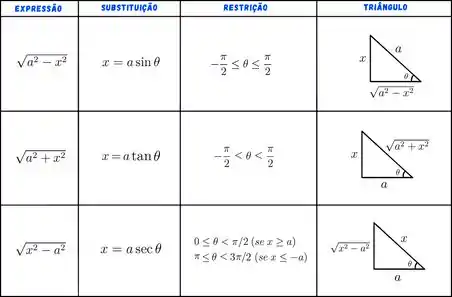Calcule a integral indefinida:
Passo 1
Pessoal, essa integral será resolvida pelo método da substituição trigonométrica, porém, antes devemos fazer uma substituição simples. Seja , então:
Agora podemos utilizar a substituição trigonométrica.
Passo 2
Devemos saber qual substituição trigonométrica usar, como nós temos no denominador, isso indica a substituição com a secante, como vocês podem ver a seguir no quadro de substituições com os respectivos triângulos e intervalos.

Olhando o quadrinho, percebemos que a substituição deve ser . Façamos então a substituição:
Dessa forma, .
Passo 3
Agora vamos trocar a variável e resolver.
Aqui podemos efetuar a substituição e ficamos com:
Passo 4
Como a integral indefinida foi dada na variável , devemos dar a resposta nesta variável. Sendo , para achar nós olhamos o triângulo da substituição com construído no início e utilizamos essas relações trigonométricas. Temos então:
No triângulo está , mas nós efetuamos a substituição usando , então basta trocar. Dessa forma,
Também fizemos a substituição , logo, o resultado será: